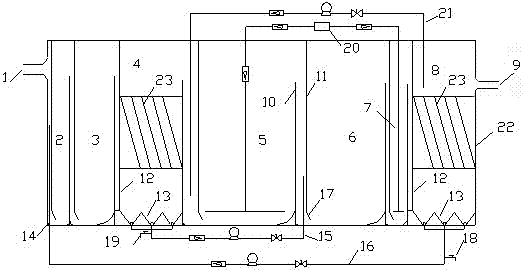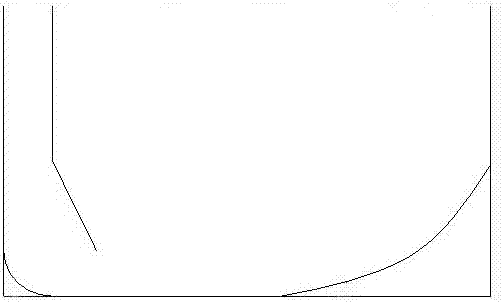An integrated device for baffle denitrification phosphorus removal and cod degradation
A technology of denitrification and phosphorus removal, integrated device, applied in chemical instruments and methods, water/sewage multi-stage treatment, water/sludge/sewage treatment, etc. Phosphorus bacteria impact and other problems, to avoid the effects of excessive phosphorus absorption and excessive phosphorus release under anaerobic conditions, reduce the impact effect, and avoid the effects of biological phase confusion
- Summary
- Abstract
- Description
- Claims
- Application Information
AI Technical Summary
Problems solved by technology
Method used
Image
Examples
Embodiment 1
[0030] The petrochemical wastewater after air flotation treatment (CODcr is 330mg / L, ammonia nitrogen concentration is 30mg / L, TP is 5mg / L) enters the first anaerobic compartment (2) through the water inlet (1), and is mixed with the return sludge The pH is around 7 to degrade COD and remove refluxed nitrate nitrogen. Then flow into the second anaerobic compartment (3) and adjust the pH to about 7.5 by adding lye, and the denitrifying phosphorus-accumulating bacteria perform anaerobic phosphorus release and degrade COD to synthesize energy and store it in the body. After the separation of mud and water in the middle sedimentation compartment (4), the sludge overflows to the anoxic compartment (6), with an excess ratio of 30%; while the supernatant enters the nitrification compartment (5). The pH of the supernatant entering the nitrification cell (5) is adjusted to about 8.0, and the nitrifying bacteria oxidize the ammonia nitrogen in the supernatant to nitrate nitrogen, etc., ...
Embodiment 2
[0035] Processing method is as embodiment 1. .The specific operating indicators are:
[0036] The CODcr of petrochemical wastewater after air flotation treatment is 230mg / L, the concentration of ammonia nitrogen is 20mg / L, the concentration of TP is 3 mg / L, the water temperature is 30°C, and the pH value is 7.0.
[0037] The measured COD of the effluent was 40 mg / L, the concentration of ammonia nitrogen was only 1 mg / L, the concentration of TN was 3.5 mg / L, and the concentration of TP was 0.3 mg / L. The removal rates of COD, ammonia nitrogen and TP were respectively 83% and 95%. 90%, the effluent reaches the first-class A standard stipulated by the state.
Embodiment 3
[0039] Processing method is as embodiment 1. .The specific operating indicators are:
[0040] The CODcr of petrochemical wastewater after air flotation treatment is 430mg / L, the concentration of ammonia nitrogen is 44mg / L, the concentration of TP is 7 mg / L, the water temperature is 30°C, and the pH value is 7.0.
[0041] The measured COD of the effluent was 48 mg / L, the concentration of ammonia nitrogen was only 2 mg / L, the concentration of TN was 6.5 mg / L, and the concentration of TP was 0.4 mg / L. The removal rates of COD, ammonia nitrogen and TP reached 89% and 95% respectively. 94%, the effluent reaches the first-class A standard stipulated by the state.
[0042] This device adopts the theory of denitrification phosphorus removal, which not only solves the problem of insufficient carbon source caused by substrate competition in the traditional biological phosphorus removal process, but also avoids the contradiction between the sludge age mismatch between nitrifying bacteri...
PUM
 Login to View More
Login to View More Abstract
Description
Claims
Application Information
 Login to View More
Login to View More - R&D
- Intellectual Property
- Life Sciences
- Materials
- Tech Scout
- Unparalleled Data Quality
- Higher Quality Content
- 60% Fewer Hallucinations
Browse by: Latest US Patents, China's latest patents, Technical Efficacy Thesaurus, Application Domain, Technology Topic, Popular Technical Reports.
© 2025 PatSnap. All rights reserved.Legal|Privacy policy|Modern Slavery Act Transparency Statement|Sitemap|About US| Contact US: help@patsnap.com


